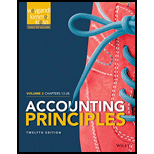
Decision-making process:
Decision making can be defined as the process of making choices through the identification of a decision, collecting information, and assessing alternative resolutions. The implementation of a step-by-step process of decision making helps in making deliberate and effective decisions through proper organization of relevant information and defining alternatives.
To determine: The steps involved in management’s decision making process.
Explanation of Solution
Management decision making process does not always adhere to a set pattern due to the dynamic nature of decision making process. However, few essential steps involved in the decision making process are as follows:
- Identify the problem and assign responsibility.
- Determine and evaluate possible courses of action, based on the relevant revenue and cost data. The evaluation will reveal the expected overall effect on the net income.
- Make a decision based on both financial and non-financial information such as information pertaining to revenue and cost and their effect on company’s overall profitability, decision on employee turnover, etc.
- Review results of the decision. Here, accounting prepares internal reports that review the actual impact of the decision.
Hence, the steps involved in management’s decision making process are explained as above.
Want to see more full solutions like this?
Chapter 26 Solutions
Accounting Principles, Volume 2: Chapters 13 - 26
- Which of the following is an example of an intangible asset? A) Buildings B) Patents C) Equipment D) Inventoryarrow_forwardRivera Products sells its product for $18 per unit. Next year, fixed expenses are expected to be $395,000, and variable expenses are expected to be $11 per unit. How many units must the company sell to generate a net operating income of $85,000?arrow_forwardWhat is the value of erosion?arrow_forward
- What is the purpose of adjusting entries in accounting? A) To close the temporary accounts B) To update the financial records at the end of an accounting period C) To prepare the trial balance D) To record transactions that occurred in the following periodarrow_forwardThe total factory overhead for Leicester Manufacturing is budgeted for the year at $756,000. Leicester manufactures two product lines: standard lamps and premium lamps. These products each require 4 direct labor hours to manufacture. Each product is budgeted for 8,000 units of production for the year. Determine the factory overhead allocated per unit for premium lamps using the single plantwide factory overhead rate.arrow_forwardWhich of the following is an example of an intangible asset? A) Buildings B) Patents C) Equipment D) Inventoryexplain.arrow_forward
- If a company has a profit margin of 10%, this means that:A) For every $1 of sales, the company earns $0.10 in profit.B) The company has $0.10 in expenses for every $1 of sales.C) The company’s revenue exceeds its expenses by 10%.D) The company’s assets exceed its liabilities by 10%.arrow_forwardPlease accounting problemarrow_forwardCan you solve this general accounting problem using accurate calculation methods?arrow_forward

 AccountingAccountingISBN:9781337272094Author:WARREN, Carl S., Reeve, James M., Duchac, Jonathan E.Publisher:Cengage Learning,
AccountingAccountingISBN:9781337272094Author:WARREN, Carl S., Reeve, James M., Duchac, Jonathan E.Publisher:Cengage Learning, Accounting Information SystemsAccountingISBN:9781337619202Author:Hall, James A.Publisher:Cengage Learning,
Accounting Information SystemsAccountingISBN:9781337619202Author:Hall, James A.Publisher:Cengage Learning, Horngren's Cost Accounting: A Managerial Emphasis...AccountingISBN:9780134475585Author:Srikant M. Datar, Madhav V. RajanPublisher:PEARSON
Horngren's Cost Accounting: A Managerial Emphasis...AccountingISBN:9780134475585Author:Srikant M. Datar, Madhav V. RajanPublisher:PEARSON Intermediate AccountingAccountingISBN:9781259722660Author:J. David Spiceland, Mark W. Nelson, Wayne M ThomasPublisher:McGraw-Hill Education
Intermediate AccountingAccountingISBN:9781259722660Author:J. David Spiceland, Mark W. Nelson, Wayne M ThomasPublisher:McGraw-Hill Education Financial and Managerial AccountingAccountingISBN:9781259726705Author:John J Wild, Ken W. Shaw, Barbara Chiappetta Fundamental Accounting PrinciplesPublisher:McGraw-Hill Education
Financial and Managerial AccountingAccountingISBN:9781259726705Author:John J Wild, Ken W. Shaw, Barbara Chiappetta Fundamental Accounting PrinciplesPublisher:McGraw-Hill Education





